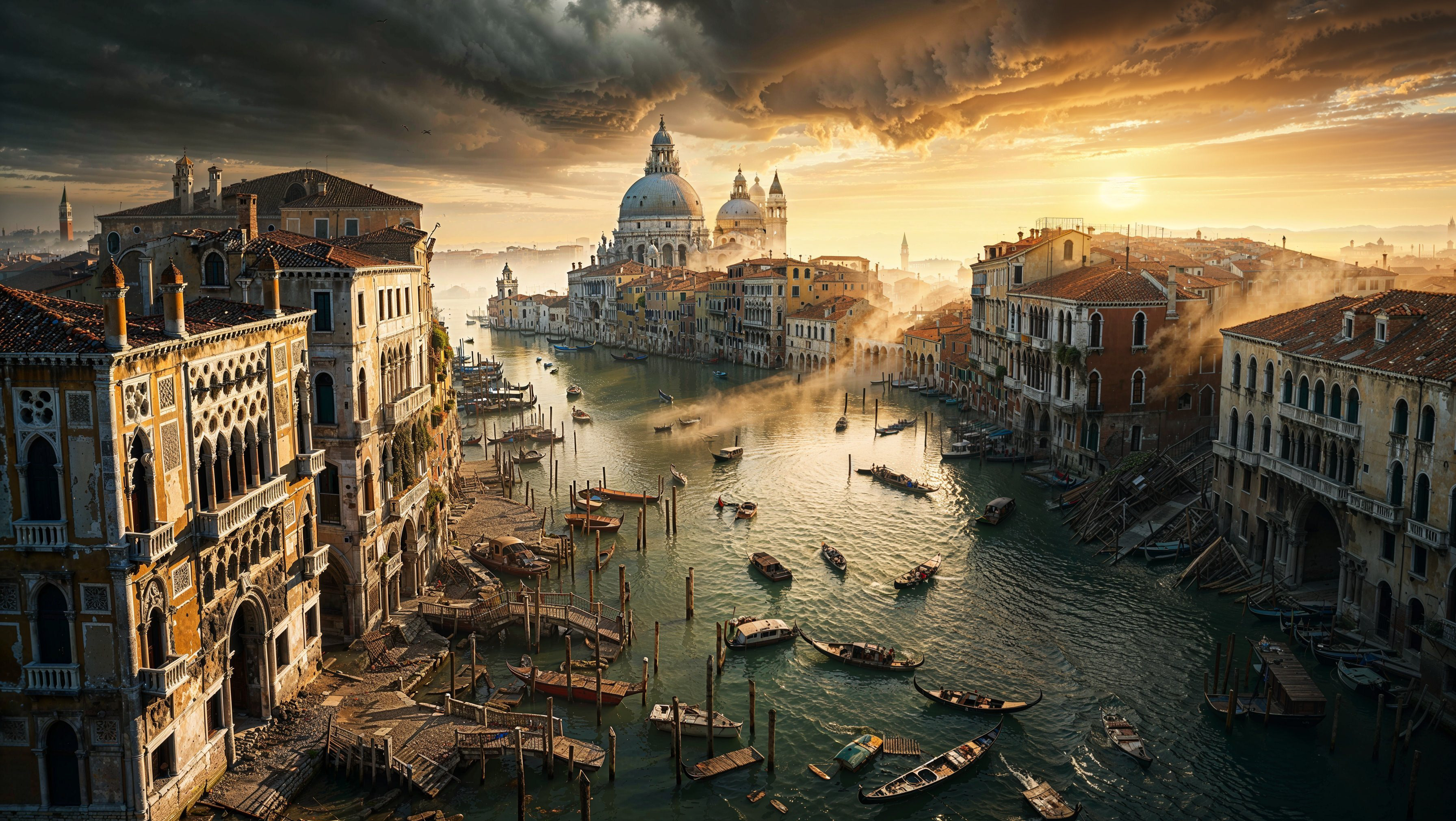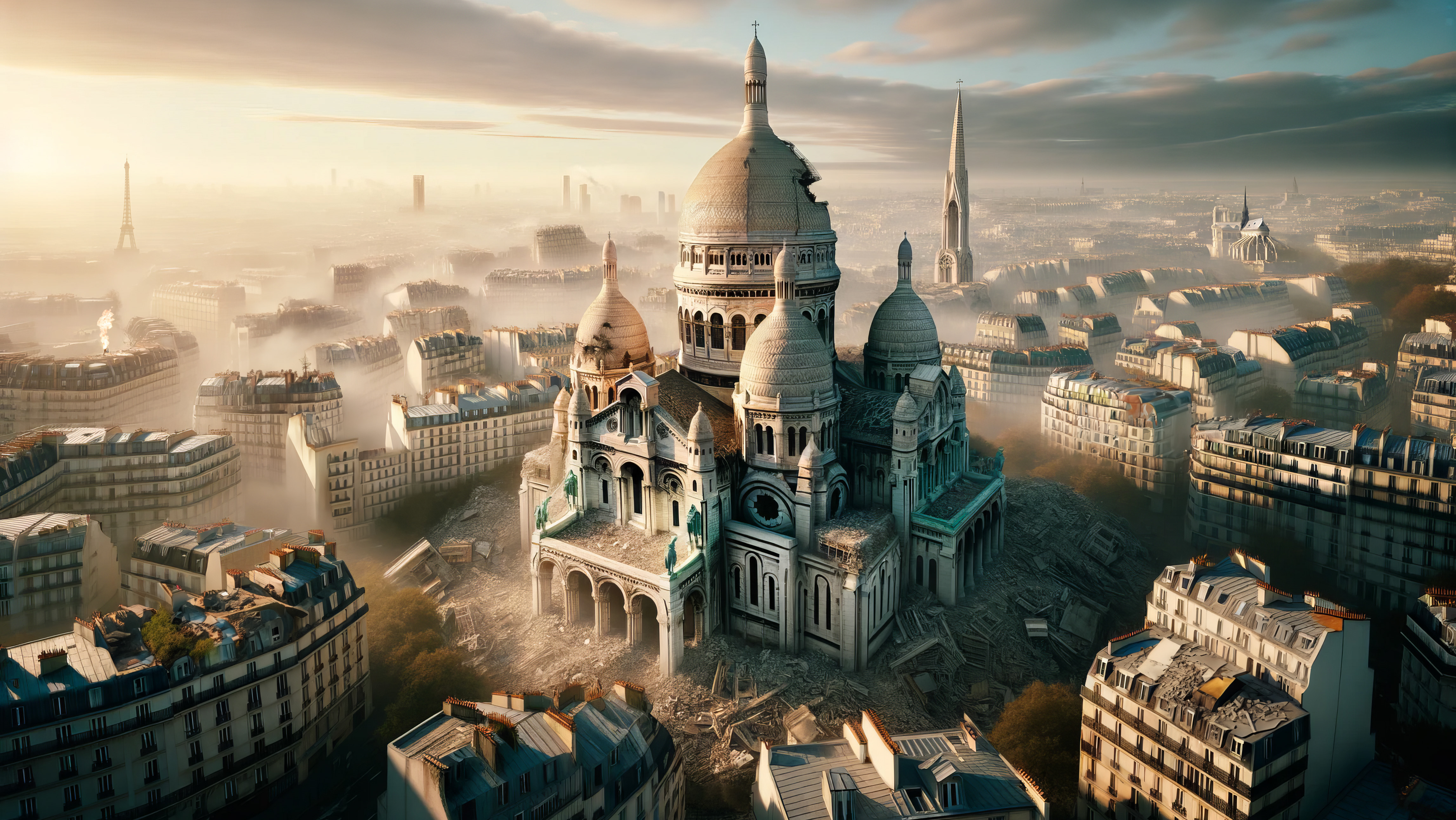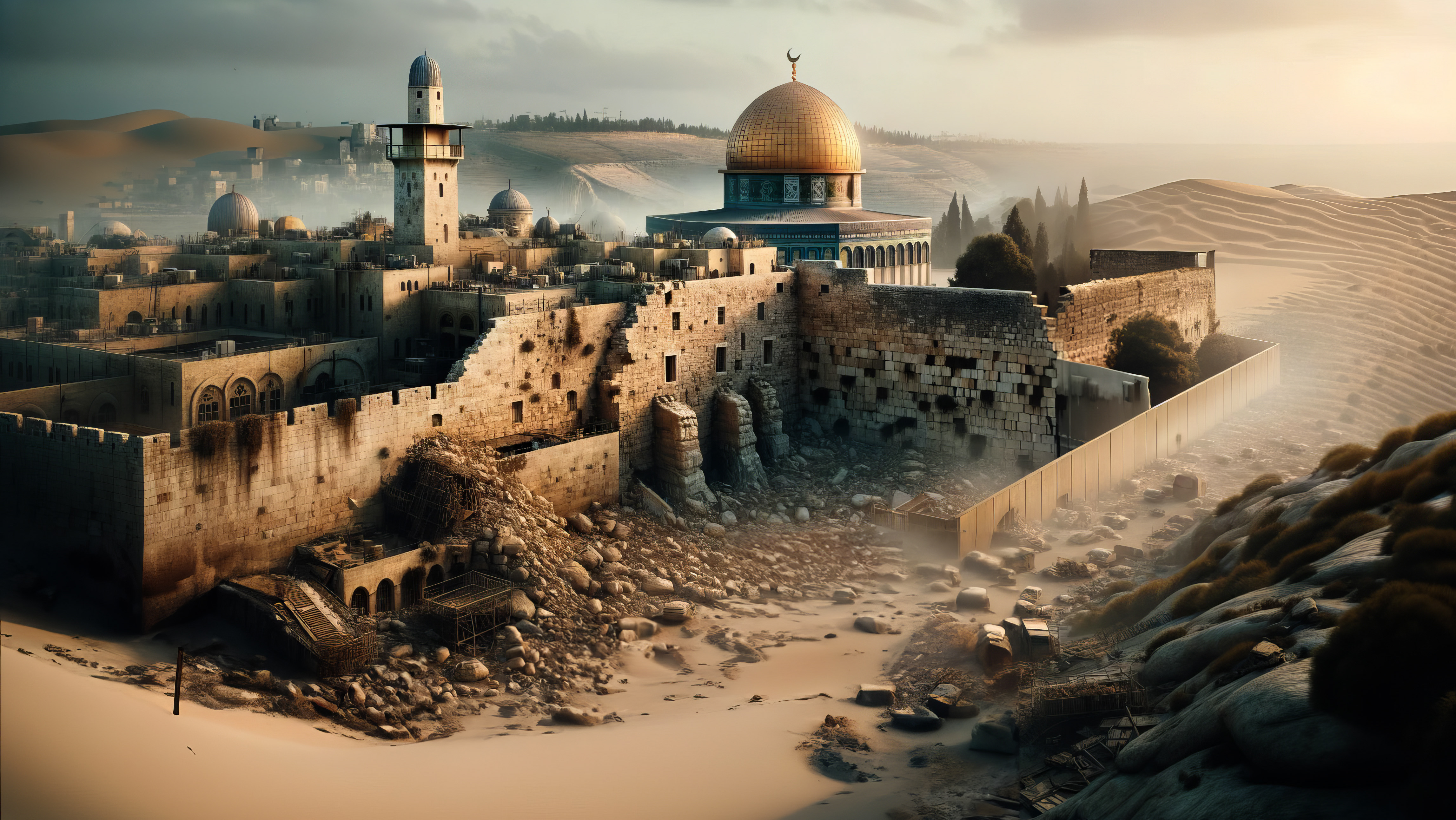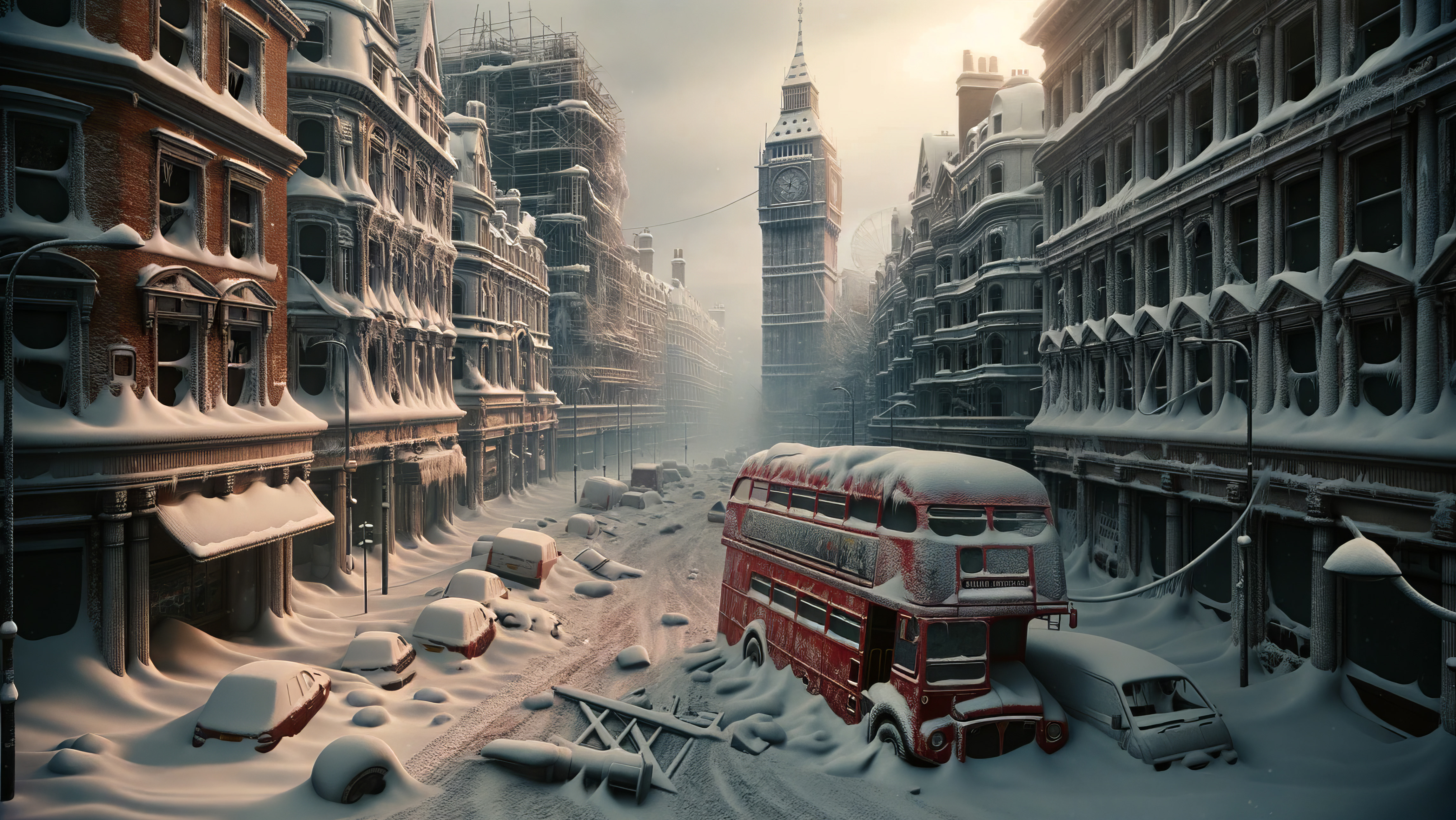Temporal Reverberations: Embarking on a New Chapter
… As I stood amidst the ancient structures of Jerusalem, the fading echoes of my recent digital journey still resonating in my mind, I felt the weight of time and responsibility. The vast digital repository I had created in the previous chapter of my expedition, intricately weaving my findings into the boundless tapestry of the internet, was a testament to the unyielding spirit of exploration and knowledge preservation. But my journey was far from over. Jerusalem's silent streets, laden with history, mystery, and untold tales, beckoned me to delve deeper.
Reflecting upon my earlier explorations, I realised that while I had uncovered layers of the city's history and culture, there remained a multitude of stories yet to be discovered. The next phase of my journey would take me to lesser-known corners of Jerusalem, where the whispers of the past intermingled with the shadows of the present. These were places where the passage of time was most palpable, where every stone and every gust of wind seemed to harbour a secret.
Drawing inspiration from the knowledge I had already archived, I prepared myself for this new chapter. Armed with a renewed sense of purpose and curiosity, I set forth, eager to uncover the stories that lay hidden in the heart of this ancient city. Little did I know that this next phase would present challenges and revelations that would forever change my understanding of Jerusalem and its timeless legacy.
With the horizon painted in hues of dawn and the city bathed in the soft glow of the rising sun, I began my journey anew, ready to embrace the adventures that awaited.
Chronicles of Culture Amidst Desert Sands: A Journey Through Time's Imprint
The relentless desert sun, in its zenith, cast an illuminating glow on the city's structures. Guided by whispers of ancient lore, I arrived at the gates of the Israel Museum. Established in the mid-20th century, this beacon of cultural and historical preservation had once showcased the artistic and archaeological wonders of the region. While the museum's exterior bore the scars of time and the onslaught of the desert, its spirit of preservation remained indomitable.
The museum's iconic Shrine of the Book, renowned for housing the Dead Sea Scrolls, now presented a juxtaposition of past and present, its contemporary design partially obscured by encroaching dunes. Its white dome, gleaming against the desert backdrop, seemed to echo tales from epochs long gone. The modernist architecture, with its clean, stark lines, served as a stark contrast to the surrounding desert, a testament to humanity's drive to immortalise its legacy.
Venturing inside, I was greeted by halls filled with silent witnesses of bygone eras. Exhibits, though shrouded in a fine layer of dust, narrated tales spanning millennia. From ancient pottery, echoing the daily lives of civilisations past, to manuscripts that held the wisdom of scholars and sages, every artefact had a story to tell. Contemporary art installations, juxtaposed against these ancient relics, wove a narrative of a civilisation’s journey through time, its aspirations, dreams, and the undying quest for expression.
As I meandered through the museum's corridors, I was particularly captivated by an interactive exhibit. While its technology had long since ceased functioning, its intent was clear—a bridge between the past and the present, a dialogue between generations. This exhibit, like the museum itself, served as a poignant reminder of the interplay between culture, history, and the inexorable march of time.
Leaving the museum, the weight of centuries bore heavily on my shoulders. Yet, amidst the silence and the sands, there resonated a message of hope, resilience, and the eternal desire of humanity to leave an indelible mark upon the canvas of time.
Silent Artistry and Spiritual Heritage: A Tapestry of Dreams and Devotion
The day's journey, filled with discoveries and reflections, led me to the serene beauty of the Ein Karem neighbourhood. Nestled in the western hills of Jerusalem, this historic village had seen epochs come and go. Its stone houses, which whispered tales of bygone days, winding alleys that echoed the footsteps of artists, writers, and thinkers, and ancient springs that had quenched the thirst of generations, painted a picture of timeless beauty and tradition.
Ein Karem, renowned as the birthplace of John the Baptist, was a confluence of history, spirituality, and creativity. Its winding streets, once alive with the hum of daily life, music, laughter, and spirited debates, now lay silent, waiting for the next chapter in its story. The artist studios, galleries, and cafes, once the heart and soul of a vibrant community, stood as silent sentinels to a bygone era.
As I wandered through the village, I was captivated by an old artist's studio. The door, slightly ajar, invited me in. Inside, amidst the cobwebs and layers of dust, lay a world frozen in time. Paintbrushes, still stained with vibrant hues, palettes bearing the remnants of a masterpiece in the making, and canvases that captured the artist's dreams, hopes, and emotions, told a story of passion, dedication, and an undying spirit of expression.
Outside, the village's many murals and sculptures bore testament to a community that celebrated life, art, and spirituality in all its forms. These artworks, weathered by time yet undiminished in their allure, reached out, beckoning me to delve deeper into the tapestry of stories, traditions, and dreams that defined Ein Karem.
As the sun descended, casting a golden hue over the village, I took a moment to reflect. Amidst the silence, I felt a profound connection to the artists, thinkers, and dreamers who had once called Ein Karem home. Their legacy, etched in stone, paint, and memory, was a testament to the enduring spirit of creativity and the timeless quest for meaning and expression.
Silent Steps on Jerusalem's Sacred Path: A Journey of Faith and Reflection
My expedition through Jerusalem's silent streets and timeless tales continued to draw me into its profound tapestry of history, faith, and devotion. On this particular day, my path led me to the ancient cobblestone pathway of the Via Dolorosa. This sacred route believed to trace the steps Jesus took on his way to crucifixion, had seen countless pilgrims over the centuries, each retracing the Stations of the Cross, each bearing their tales of faith, hope, and redemption.
Now, in this world devoid of its inhabitants, the path lay eerily silent. Yet, each station, marked by chapels, medallions, and ancient inscriptions, echoed the profound weight of devotion and reflection from millennia. The cobblestones, worn by the countless feet that had trodden them, seemed to pulse with memories, stories, and silent prayers.
Walking this path, I felt an overwhelming connection to the multitudes who had come before me. Each station held a tale, a moment of Jesus's journey, and, by extension, the journey of countless souls seeking understanding, solace, or redemption. The weight of these collective experiences pressed upon my heart as I tried to fathom the depth of faith and devotion that this path had witnessed.
As I approached the Church of the Holy Sepulchre, the culmination of the Via Dolorosa, the setting sun cast a golden light, creating a mesmerising tableau of shadows and illuminations. This ancient church, believed to be the site of Jesus's crucifixion, burial, and resurrection, stood as a testament to faith's enduring power. Its walls whispered tales of miracles, hopes, and unwavering belief even in its silence.
I ventured inside, the coolness of the church contrasting with the desert heat outside. The scent of incense, though faint, lingered in the air, a remnant of countless ceremonies and prayers. The church's intricate mosaics, artworks, and relics bore witness to the devotion of artists, craftsmen, and believers who had poured their souls into creating this sanctuary of faith.
As night approached, I emerged from the church, my spirit enriched by the profound journey through the Via Dolorosa. The city's labyrinthine streets awaited, beckoning me to continue my exploration of Jerusalem's rich tapestry of history, faith, and human endeavour.
Deserted Markets and Cultural Crossroads: A Voyage Through Time's Labyrinths
Walking through the once-thriving streets of Jerusalem, I was drawn to the remnants of the Cardo. This ancient Roman thoroughfare, now half-buried under the sands of time, once stood as the city's vibrant arterial route. Colonnades, which had once shadowed weary travellers and bustling merchants, now stood as silent sentinels, their grandeur hinting at the Cardo's erstwhile magnificence.
Each shopfront, now devoid of life, had a story to tell. I could visualise merchants haggling, fabrics of vivid colours being traded, and the aroma of exotic spices filling the air. Intricate mosaics beneath my feet, though faded, painted tales of trade routes, distant lands, and Jerusalem's pivotal role as a cultural and commercial nexus.
Venturing deeper into this commercial hub, I discovered inscriptions in various languages — a testament to the city's multicultural tapestry. The Cardo had not just been a marketplace; it had been a melting pot where traders from distant lands shared stories, goods, and dreams.
Pausing by a particularly well-preserved stall, I unearthed an ancient coin. Its inscriptions, though worn, hinted at trade links with a far-off civilisation. Holding it, I felt the weight of centuries in my palm — a tangible link to the merchants who once thrived here.
As the shadows lengthened, the Cardo came alive with spectral sounds. The distant laughter of traders, the clinking of coins, and the murmur of a bygone era filled the air. Time had layered this place with memories, and I was merely a traveller, privileged to witness its tales.
With the Cardo's chronicles etched in my mind, I ventured forth, eager to uncover more of Jerusalem's cultural crossroads and the stories they held.
Reflective Waters and Ancient Healing: Mysteries in the Moonlight
The cool evening breeze guided me to the Pool of Bethesda, an ancient reservoir in Jerusalem's heart. Known for its healing properties, the pool, once a bustling centre of hope and faith, now lay silent under the luminescent moon. Its waters, still and deep, mirrored the celestial ballet above, creating a mesmerising tableau of starry reflections.
I could almost hear the whispered prayers of those searching for miracles. Their hopes, dreams, and silent pleas seemed to have seeped into the very stones and waters, making the place pulsing with otherworldly energy. Curiously, I leaned closer to the water's edge, my fingers grazing the surface. The ripples danced away, disturbing the serene reflection of the heavens above.
Suddenly, a faint glow emanated from beneath the waters. Drawn to its allure, I carefully descended the ancient steps leading into the pool. The water, surprisingly warm, revealed an intricate mosaic at its base. The design, though worn by time, depicts scenes of healing interspersed with symbols from various cultures. It was a testament to Jerusalem's multicultural legacy and the universal human yearning for healing and hope.
However, my exploration was interrupted by a sudden shift in the waters. From the deep recesses of the pool, bubbles began to emerge, growing in intensity. Realising the potential danger, I hastily retreated to the safety of the pool's edge. As I looked back, the waters had settled again into their reflective calm, the mysterious glow now gone. The pool had revealed a fragment of its secret, reminding me of the depths and layers of history hidden beneath the obvious.
With a renewed sense of wonder, I continued my journey, eager to uncover more of Jerusalem's enigmatic tales.
Guarding Jerusalem's Timeless Secrets: Echoes of Battles Past
Wandering deeper into the city’s heart, I stumbled upon the imposing Zion Gate. This historic portal, with its thick walls marred by bullet scars, stood as a mute testament to the city's tumultuous past. This gate had witnessed battles and parades, hope and despair, love and loss. The echoes of clashing swords, the chants of triumphant armies, and the hushed whispers of secret rendezvous seemed to reverberate from its stones.
Curiosity piqued, I approached the massive wooden doors of the gate. To my surprise, they creaked open slightly, revealing a dimly lit passage beyond. Heart pounding with anticipation, I stepped into the shadows. The passage, lined with ancient carvings and inscriptions, led to an underground chamber. This chamber, hidden from the world above, bore relics of a bygone era - rusted shields, faded banners, and inscriptions detailing valiant deeds.
But my discovery was interrupted by a sudden noise. Footsteps echoed in the distance. Were they remnants of the past, or had I stumbled upon something still alive in this forsaken world? I quickly took cover behind a crumbling pillar, my breaths shallow and measured.
The footsteps grew louder and then faded, leaving behind a haunting silence. Gathering courage, I decided to continue my exploration. But as I ventured deeper into the chamber, a sudden wind extinguished my torch, plunging the room into darkness. The weight of history and the unknown pressed upon me.
After what felt like an eternity, I managed to relight my torch and find my way back to the passage. The gate, still slightly ajar, beckoned me to the world above. As I emerged, the first rays of dawn painted the city in a golden hue, providing a stark contrast to the mysteries lurking below.
With my heart still racing from the unexpected adventure, I continued my journey, eager to discover more secrets that Jerusalem guarded fiercely.
Embracing Dawn in a Resilient City: Pursuit of Time's Ephemeral Beauty
The horizon began to shimmer with the first light of dawn as I ascended Mount Zion. This sacred hill, a mosaic of faiths and stories, offered unparalleled views of Jerusalem. The city, with its intricate network of streets, alleys, and courtyards, lay sprawled beneath, bathed in the ethereal glow of the breaking day.
But as I admired the view, a sudden movement caught my eye. A shadowy figure, swift and silent, darted across the rooftops below. Intrigued, I decided to follow. Navigating the city's terraces, I pursued the elusive figure, the chase taking me through hidden passages and forgotten alleys.
The pursuit led me to the ancient walls of Jerusalem. There, hidden amidst the stones, I discovered a series of murals. These artworks, untouched by time, depicted tales of heroism, love, and faith. The figure had led me to a secret gallery, a visual chronicle of Jerusalem's soul.
Lost in the beauty of the murals, I almost didn't notice the figure reappear. But instead of fleeing, it approached, revealing itself as a majestic owl, its eyes gleaming with wisdom. It nodded in approval, acknowledging our shared discovery.
As the sun climbed higher, casting the city in a warm, golden light, I realised that Jerusalem was not just a place of history and faith. It was a living, breathing entity, its stories interwoven with the very fabric of time.
With the owl as my silent companion, I set forth, eager to embrace the new day and the adventures it promised in this resilient city.
Historic Entrances in a Deserted Jerusalem: Unveiling Forgotten Tales
The morning sun cast its golden fingers over Jerusalem, revealing the timeless beauty of structures that had stood the test of centuries. These silent edifices told tales of resilience, endurance, and history intertwined.
As I walked through the ancient pathways, the Jaffa Gate, one of the city's main entrances, beckoned. Its majestic stone archway, bearing the scars of countless battles, whispered tales of kings, conquerors, and commoners who once passed through its threshold. Each footprint, each echo, seemed to be preserved in the very dust of the place.
Drawn by an inexplicable curiosity, I noticed an almost hidden side entrance. Pushing the creaky door, I found myself in a dimly lit corridor, its walls lined with inscriptions and emblems from bygone eras. Following the corridor, it led me to a vast underground chamber, its ceiling supported by massive pillars. The chamber was filled with artefacts, scrolls, and remnants of past civilisations. The air was thick with mystery and the weight of untold stories.
However, my exploration took a sudden turn when a hidden mechanism triggered, sealing the chamber's entrance. Panic surged as I realised I was trapped. With torch in hand, I frantically searched for an exit. Hours felt like days until I discovered a series of levers hidden behind a stone façade. With a combination of intuition and luck, the door finally creaked open, allowing me to breathe the fresh air again.
Emerging from the depths, the city lay bathed in the gentle hues of the afternoon, its secrets a bit more unveiled to a traveller from a distant future.
Exploring the Armenian Apostolic Legacy: Secrets of the Sacred
The Christian Quarter held its allure. The St. James Cathedral, a beacon of Armenian Apostolic faith, rose majestically against the sky. Its ornate façade and resonant chants held promises of sacred mysteries within.
Inside, the cathedral's vastness engulfed me. Gold-encrusted altars, frescoes depicting holy scenes, and the soft glow of candles created a tapestry of devotion. As I wandered through its aisles, a hidden trapdoor beneath an altar caught my attention. Descending cautiously, I found myself in a catacomb, its walls adorned with paintings and inscriptions detailing the Armenian diaspora's journey and faith.
Yet, danger lurked even here. A section of the floor gave way, sending me sliding down a chute into another chamber filled with relics and ancient scriptures. The realisation dawned that I had stumbled upon a hidden vault safeguarding the cathedral's most treasured possessions. Using the tools from my time-travel kit, I climbed back with tales of yet another adventure to tell.
Islamic Heritage Amidst Jerusalem's Silence: Echoes of Devotion
Venturing into the Muslim Quarter, the iconic silhouette of the Al-Aqsa Mosque beckoned. Its grandeur and tranquillity spoke of centuries of Islamic devotion. Even in its silence, the mosque's aura was palpable, echoing the prayers and hopes of millions.
However, the tranquillity was soon disrupted. A sudden gust of wind unveiled a hidden passage leading to the mosque's minarets. Climbing its winding steps, I reached the pinnacle, offering a panoramic view of the deserted city. But the minaret held more than just views. Concealed compartments revealed ancient manuscripts detailing Jerusalem's Islamic history, scholars, and legacy.
With the sun setting, casting the city in a golden-orange hue, I descended, carrying with me the whispers of the past and the weight of a civilisation’s legacy.
Deserted Alleys and Lost Commerce: Traces of Bygone Bazaars
The afternoon sun streamed down, casting elongated shadows as I meandered through Jerusalem's serpentine alleys. They led me to what was once the heart of commerce: the bustling Souk Khan al-Zeit or the Oil Market. Today, its once lively stalls lay abandoned, waiting for traders and customers that would never return. The air, once rich with the scents of spices, textiles, and crafts, now carried whispers of memories and the ever-present scent of encroaching desert winds.
Drawn to a particular stall, I uncovered remnants of old merchandise: ornate carpets, faded manuscripts, and intricately designed jewellery. Each artefact told a story, a snapshot of a time when commerce and culture thrived here.
Yet, the alleys held more than just memories. A soft rustle caught my attention. Following the sound, I found a hidden chamber beneath a vendor's stall. Ancient coins, scrolls, and mysterious artefacts hinted at clandestine trade and secret deals that once flourished in these underground hideaways.
Hurva Synagogue and Resilient Faith: The Phoenix of Jerusalem
The setting sun casts a golden glow upon the Jewish Quarter, highlighting the iconic dome of the Hurva Synagogue. A testament to hope and perseverance, the structure had risen from ashes multiple times, embodying the indomitable spirit of the Jewish community.
Inside, the hallowed chambers resonated with the echoes of prayers, chants, and ceremonies from centuries past. But amidst the spiritual aura, a peculiar mosaic on the floor caught my eye. Deciphering its symbols led me to a concealed alcove containing ancient Torah scrolls, their parchments still vivid with ink.
Yet, not all was still. A sudden gust caused a chandelier to sway, revealing a trapdoor. Curiosity piqued, I descended into a crypt-like chamber. Here, the walls bore inscriptions detailing the synagogue's storied past, its triumphs, tragedies, and the undying faith of its congregation.
Unearthing Jerusalem's Ancient Core: The Heartbeat of Millennia
The twilight hour found me at the City of David, the ancient heartbeat of Jerusalem. The remnants of walls, palaces, and tunnels whispered tales of grandeur, intrigue, and spirituality. Each stone, each artefact, seemed to pulse with the memories of kings, prophets, and ordinary souls whose lives were intertwined with the city's fate.
Drawn to the Gihon Spring, I reflected upon its significance as the city's life-giving source. However, the serene ambience was shattered when the ground beneath trembled. An ancient aqueduct, destabilised over centuries, collapsed, sending me into an underground reservoir.
In the dim light, I realised I was in a network of ancient tunnels. Using the luminescent tools from my traveller’s kit, I navigated the labyrinthine passages, discovering inscriptions, hidden chambers, and remnants of daily life from millennia past. After what felt like hours, I emerged, greeted by the moon's soft glow, casting a silvery sheen over the ancient core of Jerusalem.
Echoes of Battles and Celebrations: A Prelude to New Horizons
As my journey through Jerusalem reached its twilight, I was atop the Tower of David, the city's ancient citadel. The panoramic view from this vantage point showcased the city's rich tapestry of faith, culture, and history. From this height, the sounds of the city seemed to converge, forming an ethereal symphony of battles fought, victories celebrated, and tales of undying hope.
Each echo, each whisper, was a testament to the spirit of Jerusalem. A spirit that had endured through millennia, standing tall against the ravages of time and human conflict. As I stood there, immersed in reflection, the horizon began to shift, painting the sky with hues of amber and gold. The sunset over Jerusalem was nothing short of magical, a fitting finale to my journey through time.
Yet, as the final rays of the sun dipped below the horizon, my thoughts turned to the future. My time in Jerusalem had ended, but another adventure awaited.
The vast, icy expanse of Antarctica beckoned. Under the pristine skies of the southernmost continent, I planned to witness the celestial spectacle of Halley's Comet in 2061.
With the knowledge and tools of my advanced civilisation, I hoped to establish a temporal observatory in Antarctica, allowing me to study the comet's trajectory and its significance throughout Earth's history. The promise of this upcoming expedition filled me with anticipation and excitement.
But for now, as the stars began to twinkle over Jerusalem, I took a moment to reflect, cherish, and bid farewell to a city that had shared its soul with a traveller from a distant future.









